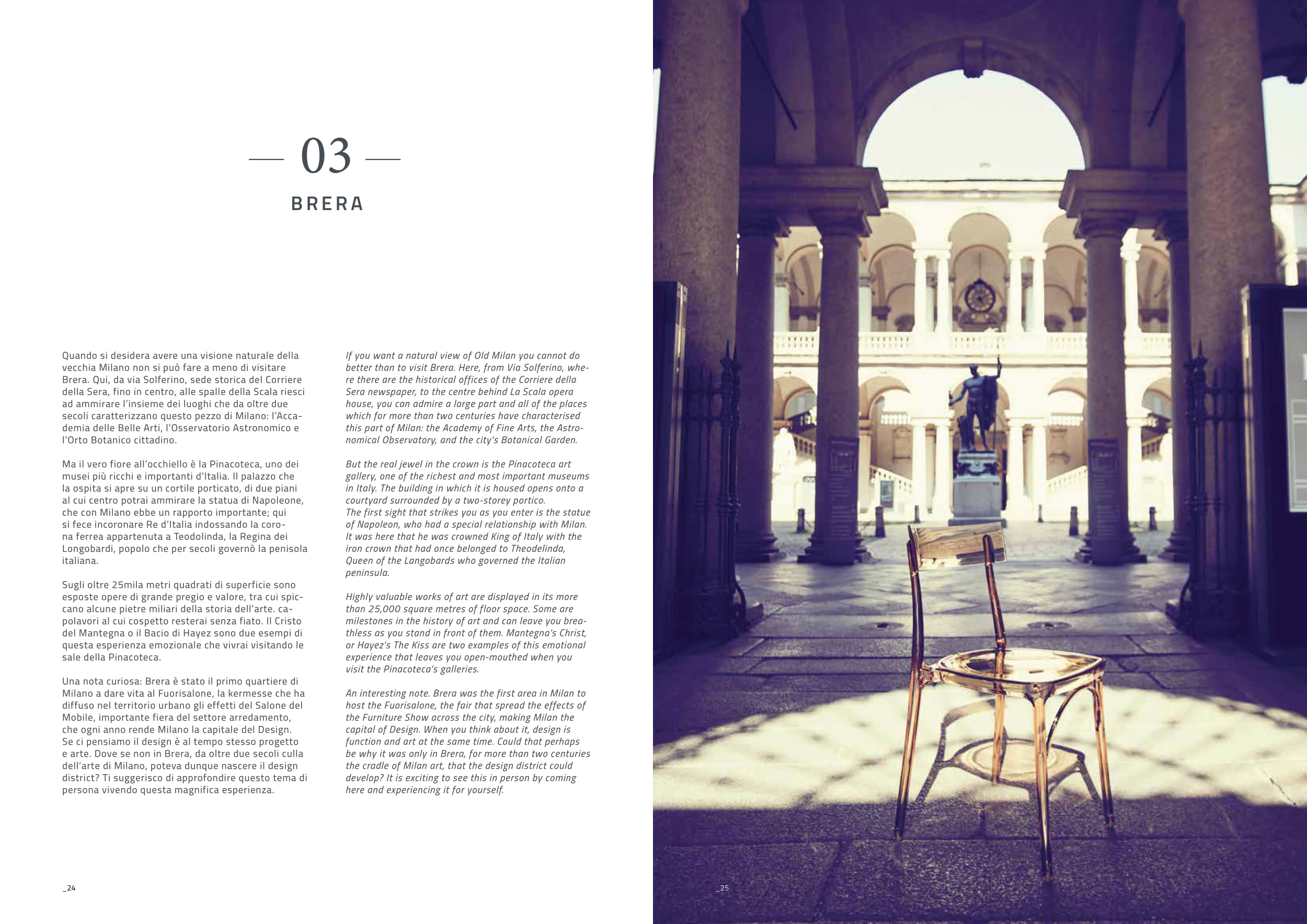03
B R E R a
Quando si desidera avere una visione naturale della
vecchia Milano non si può fare a meno di visitare
Brera. Qui, da via Solferino, sede storica del Corriere
della Sera, fino in centro, alle spalle della Scala riesci
ad ammirare l’insieme dei luoghi che da oltre due
secoli caratterizzano questo pezzo di Milano: l’Acca-
demia delle Belle Arti, l’osservatorio Astronomico e
l’orto Botanico cittadino.
Ma il vero fiore all’occhiello è la Pinacoteca, uno dei
musei più ricchi e importanti d’Italia. Il palazzo che
la ospita si apre su un cortile porticato, di due piani
al cui centro potrai ammirare la statua di Napoleone,
che con Milano ebbe un rapporto importante; qui
si fece incoronare Re d’Italia indossando la coro-
na ferrea appartenuta a Teodolinda, la Regina dei
Longobardi, popolo che per secoli governò la penisola
italiana.
Sugli oltre 25mila metri quadrati di superficie sono
esposte opere di grande pregio e valore, tra cui spic-
cano alcune pietre miliari della storia dell’arte. ca-
polavori al cui cospetto resterai senza fiato. Il Cristo
del Mantegna o il Bacio di Hayez sono due esempi di
questa esperienza emozionale che vivrai visitando le
sale della Pinacoteca.
Una nota curiosa: Brera è stato il primo quartiere di
Milano a dare vita al Fuorisalone, la kermesse che ha
diffuso nel territorio urbano gli effetti del Salone del
Mobile, importante fiera del settore arredamento,
che ogni anno rende Milano la capitale del Design.
Se ci pensiamo il design è al tempo stesso progetto
e arte. Dove se non in Brera, da oltre due secoli culla
dell’arte di Milano, poteva dunque nascere il design
district? Ti suggerisco di approfondire questo tema di
persona vivendo questa magnifica esperienza.
If you want a natural view of Old Milan you cannot do
better than to visit Brera. Here, from Via Solferino, whe-
re there are the historical offices of the Corriere della
Sera newspaper, to the centre behind La Scala opera
house, you can admire a large part and all of the places
which for more than two centuries have characterised
this part of Milan: the Academy of Fine Arts, the Astro-
nomical Observatory, and the city’s Botanical Garden.
But the real jewel in the crown is the Pinacoteca art
gallery, one of the richest and most important museums
in Italy. The building in which it is housed opens onto a
courtyard surrounded by a two-storey portico.
The first sight that strikes you as you enter is the statue
of napoleon, who had a special relationship with Milan.
It was here that he was crowned King of Italy with the
iron crown that had once belonged to Theodelinda,
Queen of the Langobards who governed the Italian
peninsula.
Highly valuable works of art are displayed in its more
than 25,000 square metres of floor space. Some are
milestones in the history of art and can leave you brea-
thless as you stand in front of them. Mantegna’s Christ,
or Hayez’s The Kiss are two examples of this emotional
experience that leaves you open-mouthed when you
visit the Pinacoteca’s galleries.
An interesting note. Brera was the first area in Milan to
host the Fuorisalone, the fair that spread the effects of
the Furniture Show across the city, making Milan the
capital of Design. When you think about it, design is
function and art at the same time. Could that perhaps
be why it was only in Brera, for more than two centuries
the cradle of Milan art, that the design district could
develop? It is exciting to see this in person by coming
here and experiencing it for yourself.
_25
_24


